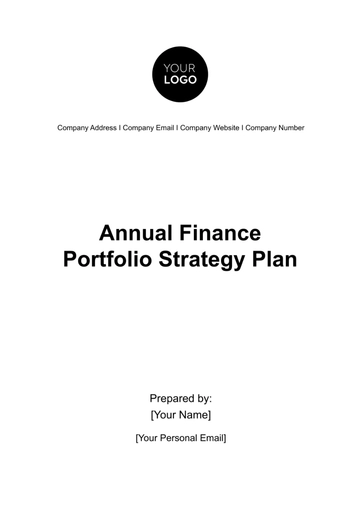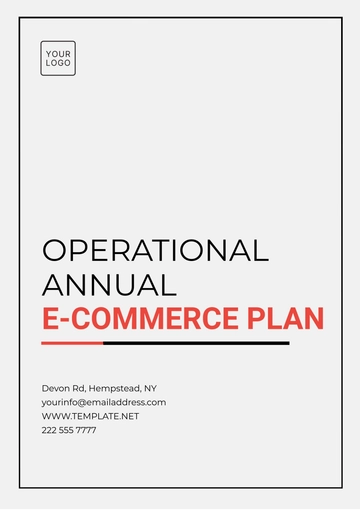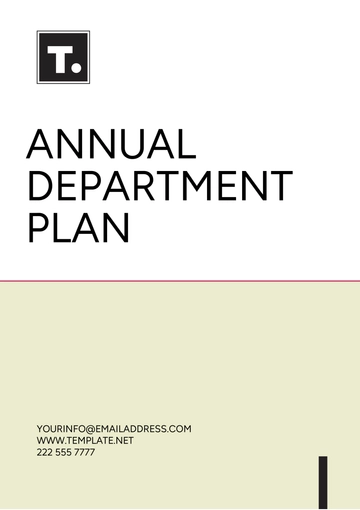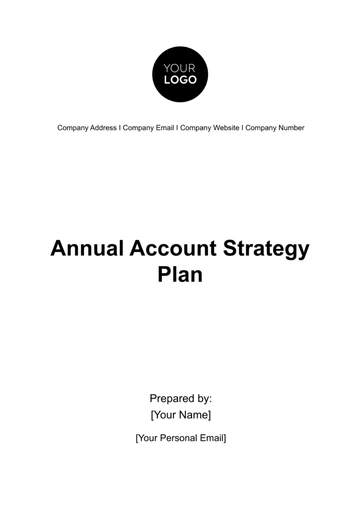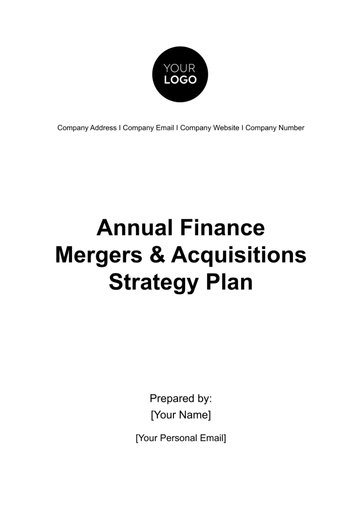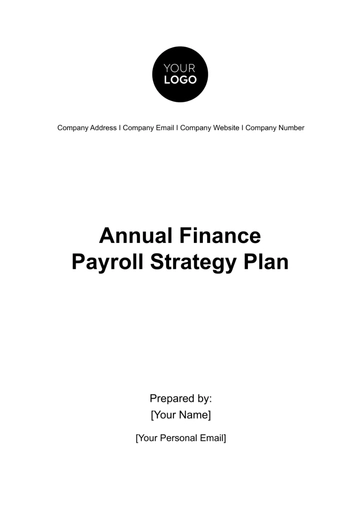Free Annual Finance Portfolio Strategy Plan
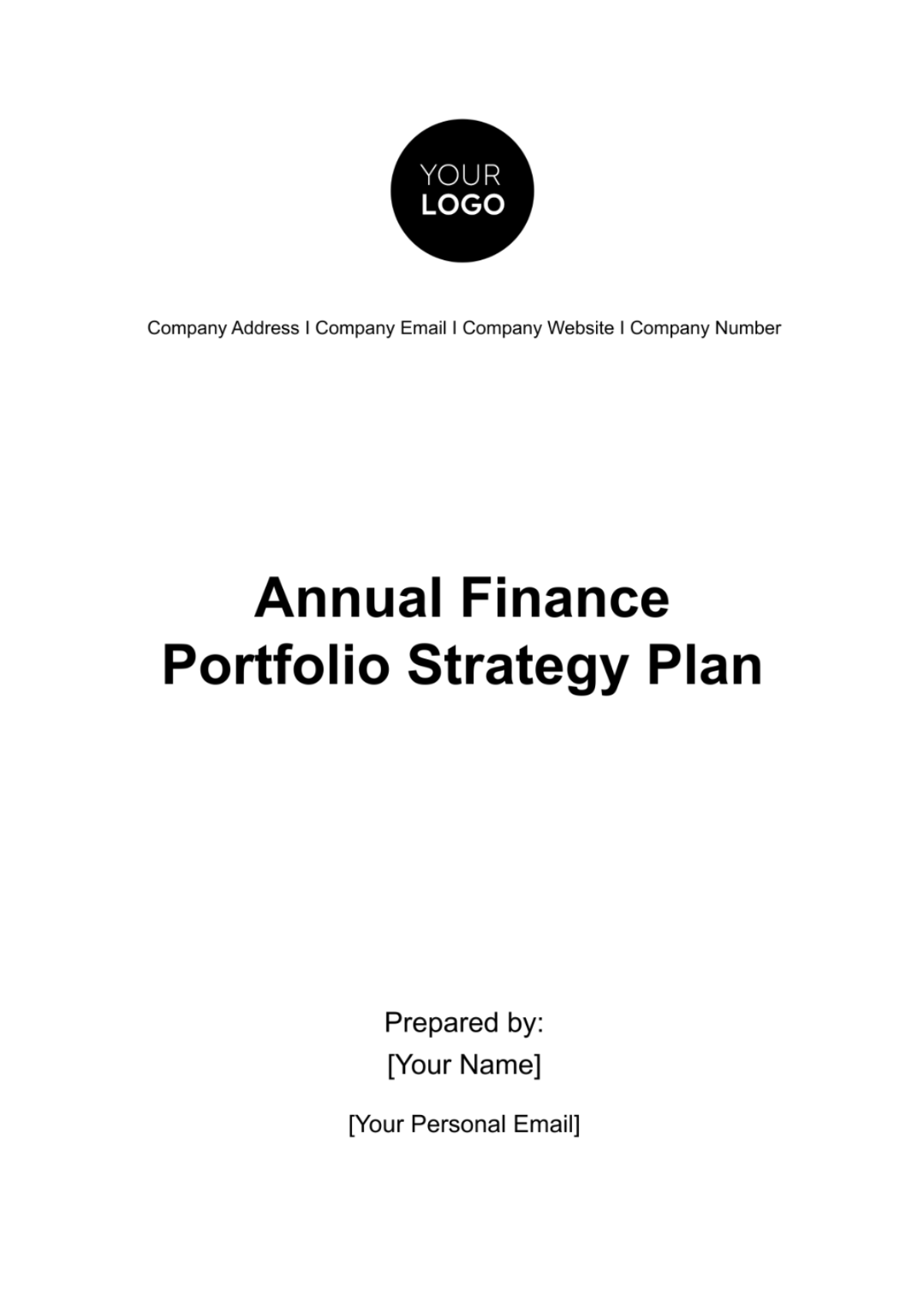
Executive Summary
The Annual Finance Portfolio Strategy Plan for [Your Company Name] serves as a pivotal guide for navigating the financial year [Month Day Year]. This plan is meticulously crafted to bolster our financial performance and catalyze sustainable growth within our organization. Recognizing the dynamic and often unpredictable nature of the market, our strategy is tailored to be both robust and flexible, allowing us to swiftly adapt to market changes and seize emerging opportunities.
Central to our approach is a commitment to prudent investment decisions. We will focus on diversifying our investment portfolio to balance risk and reward effectively. Our investment in a mix of equities, bonds, real estate, and cash equivalents is designed to optimize returns while cushioning the business against market volatilities. Additionally, an emphasis on thorough research and due diligence before any financial commitment will be paramount.
Risk management is another cornerstone of our strategy. By identifying potential risks early and implementing tailored mitigation strategies, we aim to safeguard our assets and ensure financial stability. This proactive stance on risk will involve regular monitoring of our financial activities and the external environment to make timely adjustments.
Resource allocation in this fiscal year will be directed towards areas that promise the highest return on investment, aligning with our long-term strategic goals. This includes investing in emerging technologies or markets that offer potential growth, and scaling down or restructuring less profitable or riskier ventures.
Overall, the Annual Finance Portfolio Strategy Plan is a comprehensive roadmap that aligns our financial goals with actionable strategies. By following this plan, [Your Company Name] is poised to not only navigate the complexities of the current financial landscape but also to emerge as a stronger, more resilient enterprise.
Company Overview
At [Your Company Name], we have established ourselves as a distinguished entity in the [industry] sector, renowned for our innovative approach and commitment to excellence. Our company stands at the forefront of the [industry], consistently setting benchmarks in quality and customer satisfaction.
Company Profile:
Company Name: [Your Company Name]
Address: [Your Company Address]
Website: [Your Company Website]
Email: [Your Company Email]
Phone: [Your Company Phone Number]
Social Media: [Your Social Media]
Business Description:
[Your Company Name], a leader in the [industry] industry, is acclaimed for delivering [brief description of products/services]. Our product portfolio ranges from [product/service type 1] to [product/service type 2], catering to a diverse clientele across various sectors including [mention specific sectors like retail, B2B, technology, etc.].
At the core of our operations is the mission to [mission statement], which guides our every endeavor. This mission is reflected in our commitment to innovation, quality, and customer service. Our approach is customer-centric, focusing on understanding and meeting the unique needs of each client. We pride ourselves on our ability to offer customized solutions that are not only effective but also sustainable and forward-thinking.
Our team comprises industry veterans and dynamic professionals who bring a wealth of knowledge and expertise to the table. Together, we strive to stay ahead of industry trends, ensuring that [Your Company Name] remains synonymous with excellence and innovation in the [industry] market.
With a strong foundation built on [key business values, e.g., integrity, innovation, customer satisfaction], [Your Company Name] is dedicated to growing its presence both domestically and internationally, continuing to break new ground and set higher standards in the [industry] industry.
Market Analysis
Industry Overview:
The [industry] sector is currently experiencing [current industry trend, e.g., rapid growth, technological advancements, increased competition]. This trend is largely driven by [key factors influencing the trend, such as technological innovations, shifts in consumer preferences, regulatory changes]. For [Your Company Name], this presents both opportunities and challenges. On the one hand, the growth and dynamism of the industry offer avenues for expansion and the introduction of new products/services. On the other hand, the evolving landscape necessitates continuous adaptation and investment in areas like technology and skill development to maintain a competitive edge.
Competitor Analysis:
In the [industry] market, [Your Company Name] faces competition from major players such as [list major competitors]. However, our unique selling propositions set us apart. These include [list unique selling propositions, e.g., innovative product features, superior customer service, strong brand reputation, competitive pricing strategy]. These differentiators not only define our brand but also enable us to capture and retain a significant market share. By continuously enhancing these aspects, we aim to not only compete effectively but also redefine industry standards.
Economic Forecast:
Looking ahead to [upcoming year], the economic forecast for the [industry] sector is [positive/negative/mixed]. Analysts predict [brief overview of economic predictions relevant to the industry, such as growth rates, potential market disruptions, expected regulatory changes]. This forecast suggests that [Your Company Name] should [recommended actions based on forecast, e.g., invest in new technologies, explore new markets, tighten cost controls]. By staying abreast of these economic trends and adapting our strategies accordingly, we can position ourselves to capitalize on new opportunities and mitigate potential risks.
Financial Objectives
The financial objectives for [Your Company Name] for the upcoming fiscal year are strategically designed to propel the company towards sustainable growth and increased profitability. These objectives are quantifiable and align with our overarching business goals.
Revenue Growth:
Objective: Achieve an annual revenue growth of 8%.
Rationale: This target is set in consideration of our past performance, market potential, and the introduction of new products/services. An 8% growth is both challenging and attainable, reflecting our ambition to expand while acknowledging market realities.
Profit Margin:
Objective: Maintain or improve profit margins to 15%.
Rationale: Profitability is crucial for the health and sustainability of our business. Aiming for a 15% profit margin ensures that we are not only covering our costs but are also generating sufficient profits to reinvest in the business. This target considers current cost structures and the potential for improved operational efficiencies.
Cost Reduction:
Objective: Reduce operational costs by 5%.
Rationale: Cost management is vital for improving our bottom line. A reduction of 5% in operational costs can be achieved through measures such as streamlining processes, adopting cost-effective technologies, renegotiating supplier contracts, and reducing waste. This target is realistic yet significant enough to have a noticeable impact on our financial health.
Asset Allocation:
Objective: Efficiently allocate resources across various investments to balance risk and return.
Rationale: Diversifying our investments ensures that we are not overly reliant on any single asset class or market. The aim is to balance our portfolio in a way that maximizes returns while minimizing risks. This involves regularly reviewing our investment mix and making adjustments in line with market conditions and our strategic objectives.
By setting and rigorously pursuing these financial objectives, [Your Company Name] will be well-positioned to enhance its market standing, optimize financial performance, and ensure long-term growth and stability.
Investment Strategy
The Investment Strategy of [Your Company Name] for the fiscal year is formulated to optimize our financial portfolio, ensuring a balanced approach to risk and return. Our strategy is centered around a diversified portfolio composition, with allocations across various asset classes. This diversification is not only a measure to mitigate risk but also an opportunity to capitalize on different market conditions and investment opportunities.
Portfolio Composition
The planned allocation of our investment portfolio is as follows:
Asset Class | Allocation (%) | Expected Return (%) |
|---|---|---|
Equities | 50 | 8 |
Bonds | 30 | 4 |
Real Estate | 10 | 6 |
Cash & Equivalents | 10 | 2 |
This composition is designed to balance the growth potential of equities with the stability of bonds and real estate, complemented by the liquidity provided by cash and equivalents.
Investment Criteria
When evaluating potential investments, [Your Company Name] will employ a comprehensive set of criteria to ensure alignment with our strategic objectives and risk tolerance. These criteria include:
Return on Investment (ROI): A key criterion is the expected ROI, which measures the efficiency of an investment. We target investments that promise a competitive return relative to their risk.
Risk Profile: Each investment will be assessed for its risk level. We aim to maintain a balanced risk profile in our portfolio, avoiding excessive exposure to high-risk investments.
Market Dynamics: Understanding market trends and dynamics is crucial. Investments will be selected based on their potential to benefit from current and forecasted market conditions.
Alignment with Business Goals: Investments must align with our broader business goals, such as expanding into new markets or technologies, enhancing operational efficiency, or building brand value.
Liquidity: The liquidity of an investment is important to ensure we have adequate cash flow for operational needs and unforeseen opportunities or challenges.
Diversification: We aim for a mix of investments that reduces overall portfolio risk and ensures exposure to different sectors and asset classes.
Sustainability and Ethical Considerations: Investments will be screened for sustainability and ethical compliance, aligning with our corporate social responsibility goals.
Risk Management
Effective risk management is crucial for the stability and success of [Your Company Name]. This chapter outlines our comprehensive approach to identifying potential risks and implementing strategies to mitigate them, ensuring that we are well-prepared to handle uncertainties in our business environment.
Risk Identification
In our rigorous risk assessment process, we have identified several key risks that could impact our operations and financial health:
Market Volatility: Fluctuations in the market can affect our investment returns and overall financial performance.
Credit Risk: There's a risk associated with the potential default on obligations by our debtors or counterparties.
Operational Risk: This includes risks arising from internal processes, people, and systems, or from external events that could disrupt our operations.
Compliance Risk: The potential for legal or regulatory sanctions, financial loss, or loss to reputation due to failure to comply with laws, regulations, and ethical standards.
Strategic Risk: Risks associated with the implementation of ineffective business strategies or the failure to respond to industry changes.
Cybersecurity Risk: Potential threats related to digital assets, information technology infrastructure, and data privacy.
By proactively managing these risks, [Your Company Name] aims to minimize potential negative impacts and ensure a stable, secure, and successful business environment. This comprehensive risk management approach is integral to our overall strategy and supports our commitment to long-term sustainability and growth.
Performance Metrics
To effectively track and evaluate the financial health and performance of [Your Company Name], it is essential to establish and monitor specific Key Performance Indicators (KPIs). These KPIs serve as quantifiable measures that reflect the success of our business strategies and financial objectives. By regularly assessing these metrics, we can make informed decisions, identify areas for improvement, and ensure alignment with our overall business goals.
Key Performance Indicators
The following table outlines the primary KPIs for [Your Company Name], along with their respective targets and measurement frequencies:
Revenue Growth: A target of 8% annual revenue growth is set to ensure that the company is not only maintaining its market position but also expanding. This metric will be evaluated quarterly to allow for timely adjustments in strategy if needed.
Profit Margin: Maintaining a profit margin of 15% is crucial for financial stability and growth. This KPI will be measured bi-annually, providing insight into the effectiveness of our pricing strategies, cost management, and operational efficiency.
Cost Efficiency: Achieving a 5% reduction in operational costs annually is our goal. This target is essential for enhancing profitability. Annual measurement will give us a comprehensive view of our cost-saving initiatives' effectiveness over the fiscal year.
These performance metrics are integral to our financial planning and management. They will be regularly reviewed and analyzed, enabling [Your Company Name] to maintain a strong financial position and achieve sustained growth.
Review Schedule
A systematic review schedule is pivotal for the effective management of [Your Company Name]'s financial strategy. This schedule ensures that our finance team regularly evaluates our portfolio's performance, adjusts strategies as needed, and conducts comprehensive assessments to align with our long-term financial goals.
Review Process
1. Quarterly Performance Assessment:
Every quarter, the finance team will assess the current performance of our portfolio.
Key focus areas will include reviewing the progress towards meeting our KPIs, such as revenue growth and cost efficiency.
This frequent assessment allows for quick identification of areas needing immediate attention or adjustment.
2. Bi-annual Strategic Adjustments:
Twice a year, a more in-depth review will be conducted to consider strategic adjustments.
This includes reassessing our investment allocations, risk management strategies, and overall financial objectives in the context of the prevailing market conditions and our business performance.
These sessions enable us to pivot or fine-tune our strategies, ensuring they remain relevant and effective.
3. Annual Comprehensive Evaluation:
At the end of each fiscal year, a comprehensive evaluation of our financial strategy will be undertaken.
This will encompass a thorough analysis of our annual financial performance, a review of the effectiveness of our risk management strategies, and a detailed examination of our investment portfolio.
The outcome of this evaluation will inform the development of the strategy for the upcoming year, ensuring continuous improvement and alignment with our long-term vision.
Through this structured review schedule, [Your Company Name] ensures that our financial strategy remains dynamic, responsive to market changes, and tightly aligned with our overall business objectives.
Conclusion
This Annual Finance Portfolio Strategy Plan is a roadmap for [Your Company Name]'s financial growth and stability. Through careful planning and execution, we aim to achieve our financial objectives and contribute to the company's overall success.
- 100% Customizable, free editor
- Access 1 Million+ Templates, photo’s & graphics
- Download or share as a template
- Click and replace photos, graphics, text, backgrounds
- Resize, crop, AI write & more
- Access advanced editor
Unveil Template.net's Editable Annual Finance Portfolio Strategy Plan Template! This meticulously crafted document is your key to effective financial planning. With customizable sections using our AI Editor Tool for goals, investments, risk assessment, and more, it simplifies the process of strategizing your financial portfolio. Stay ahead in the financial game with this template's user-friendly design and comprehensive features. Get started today!
You may also like
- Finance Plan
- Construction Plan
- Sales Plan
- Development Plan
- Career Plan
- Budget Plan
- HR Plan
- Education Plan
- Transition Plan
- Work Plan
- Training Plan
- Communication Plan
- Operation Plan
- Health And Safety Plan
- Strategy Plan
- Professional Development Plan
- Advertising Plan
- Risk Management Plan
- Restaurant Plan
- School Plan
- Nursing Home Patient Care Plan
- Nursing Care Plan
- Plan Event
- Startup Plan
- Social Media Plan
- Staffing Plan
- Annual Plan
- Content Plan
- Payment Plan
- Implementation Plan
- Hotel Plan
- Workout Plan
- Accounting Plan
- Campaign Plan
- Essay Plan
- 30 60 90 Day Plan
- Research Plan
- Recruitment Plan
- 90 Day Plan
- Quarterly Plan
- Emergency Plan
- 5 Year Plan
- Gym Plan
- Personal Plan
- IT and Software Plan
- Treatment Plan
- Real Estate Plan
- Law Firm Plan
- Healthcare Plan
- Improvement Plan
- Media Plan
- 5 Year Business Plan
- Learning Plan
- Marketing Campaign Plan
- Travel Agency Plan
- Cleaning Services Plan
- Interior Design Plan
- Performance Plan
- PR Plan
- Birth Plan
- Life Plan
- SEO Plan
- Disaster Recovery Plan
- Continuity Plan
- Launch Plan
- Legal Plan
- Behavior Plan
- Performance Improvement Plan
- Salon Plan
- Security Plan
- Security Management Plan
- Employee Development Plan
- Quality Plan
- Service Improvement Plan
- Growth Plan
- Incident Response Plan
- Basketball Plan
- Emergency Action Plan
- Product Launch Plan
- Spa Plan
- Employee Training Plan
- Data Analysis Plan
- Employee Action Plan
- Territory Plan
- Audit Plan
- Classroom Plan
- Activity Plan
- Parenting Plan
- Care Plan
- Project Execution Plan
- Exercise Plan
- Internship Plan
- Software Development Plan
- Continuous Improvement Plan
- Leave Plan
- 90 Day Sales Plan
- Advertising Agency Plan
- Employee Transition Plan
- Smart Action Plan
- Workplace Safety Plan
- Behavior Change Plan
- Contingency Plan
- Continuity of Operations Plan
- Health Plan
- Quality Control Plan
- Self Plan
- Sports Development Plan
- Change Management Plan
- Ecommerce Plan
- Personal Financial Plan
- Process Improvement Plan
- 30-60-90 Day Sales Plan
- Crisis Management Plan
- Engagement Plan
- Execution Plan
- Pandemic Plan
- Quality Assurance Plan
- Service Continuity Plan
- Agile Project Plan
- Fundraising Plan
- Job Transition Plan
- Asset Maintenance Plan
- Maintenance Plan
- Software Test Plan
- Staff Training and Development Plan
- 3 Year Plan
- Brand Activation Plan
- Release Plan
- Resource Plan
- Risk Mitigation Plan
- Teacher Plan
- 30 60 90 Day Plan for New Manager
- Food Safety Plan
- Food Truck Plan
- Hiring Plan
- Quality Management Plan
- Wellness Plan
- Behavior Intervention Plan
- Bonus Plan
- Investment Plan
- Maternity Leave Plan
- Pandemic Response Plan
- Succession Planning
- Coaching Plan
- Configuration Management Plan
- Remote Work Plan
- Self Care Plan
- Teaching Plan
- 100-Day Plan
- HACCP Plan
- Student Plan
- Sustainability Plan
- 30 60 90 Day Plan for Interview
- Access Plan
- Site Specific Safety Plan
